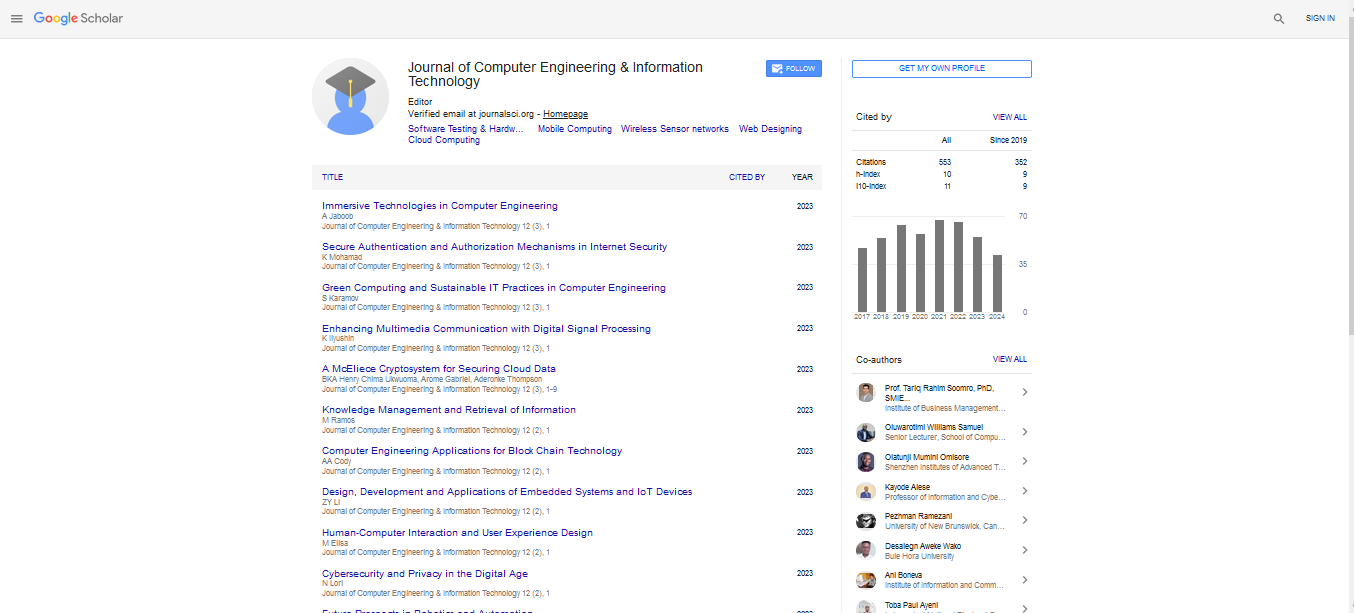Editorial, Jceit Vol: 14 Issue: 2
Low-Code/No-Code Platforms: Democratizing Software Development
Mohammad Irfan*
The Faculty of Information Technology, Monash University, Clayton, Australia
- *Corresponding Author:
- Mohammad Irfan
The Faculty of Information Technology, Monash University, Clayton, Australia
E-mail: md_irfan@yahoo.com
Received: 01-March-2025, Manuscript No jceit-25-169315; Editor assigned: 4-March-2025, Pre-QC No. jceit-25-169315 (PQ); Reviewed: 20-March-2025, QC No jceit-25-169315; Revised: 27-March-2025, Manuscript No. jceit-25-169315 (R); Published: 31-March-2025, DOI: 10.4172/2324-9307.1000337
Citation: Mohammad I (2025) Low-Code/No-Code Platforms: Democratizing Software Development. J Comput Eng Inf Technol 14: 337
Introduction
The rapid pace of digital transformation has created an unprecedented demand for software applications across industries. Yet, the shortage of skilled developers continues to challenge organizations striving to innovate quickly [1]. Low-code and no-code platforms have emerged as game-changers, empowering not only professional developers but also business users to build applications with minimal or no coding.
By simplifying the app development process through visual interfaces, drag-and-drop tools, and pre-built components, these platforms lower technical barriers and accelerate delivery. They promise to democratize software creation, enabling more people to participate in digital innovation and helping organizations stay agile in a competitive landscape.
This editorial explores the rise of low-code/no-code platforms, their benefits, challenges, and their future impact on the software development ecosystem.
What Are Low-Code and No-Code Platforms?
Low-code platforms provide a development environment where users can design applications through graphical user interfaces and minimal hand-coding, often for backend logic or integrations [2]. They strike a balance, allowing professional developers to accelerate routine tasks while retaining control over complex requirements.
No-code platforms, on the other hand, target non-technical users entirely, offering tools to build apps without writing any code. These platforms typically focus on specific use cases such as workflows, forms, and simple database applications.
Both approaches aim to reduce reliance on traditional software development methods, enabling faster prototyping, development, and deployment.
Benefits of Low-Code/No-Code Platforms
- Accelerated Development: Visual tools and reusable components speed up application delivery, helping businesses respond swiftly to market demands [3].
- Bridging the Skills Gap: Non-developers, often called “citizen developers,” can build and customize solutions, easing the burden on IT teams.
- Cost Efficiency: Reduced development time and less reliance on specialized talent lower costs.
- Improved Collaboration: Business and IT teams can work more closely, translating requirements into functional apps faster.
- Flexibility and Agility: Platforms enable rapid iteration and easier modifications in response to changing business needs.
These benefits make low-code/no-code an attractive option for digital transformation initiatives.
Challenges and Considerations
- Governance and Security: With more users building apps, ensuring compliance, data security, and integration standards can be complex.
- Scalability and Customization Limits: Some low-code/no-code solutions may struggle with highly complex or enterprise-scale applications [4].
- Vendor Lock-in: Dependence on proprietary platforms can pose risks related to pricing, flexibility, and future platform support.
- Quality and Maintainability: Applications built rapidly by non-developers might lack documentation or architectural rigor.
Organizations must implement governance frameworks and integrate these platforms thoughtfully into their IT strategy.
The Future of Low-Code/No-Code Platforms
The low-code/no-code market is growing rapidly, fueled by advances in AI, cloud computing, and API-driven architectures. Future trends include:
- AI-Assisted Development: Platforms leveraging AI to suggest workflows, auto-generate code snippets, and optimize app design.
- Integration with DevOps: Bridging low-code tools with continuous integration/continuous deployment (CI/CD) pipelines for better control [5].
- Expansion into Complex Use Cases: Increasingly sophisticated capabilities enabling low-code/no-code in areas like AI, IoT, and big data.
- Hybrid Development Models: Combining no-code ease with developer extensibility to meet diverse business needs.
As these platforms evolve, they will continue reshaping the software development landscape by fostering innovation across organizational roles.
Conclusion
Low-code and no-code platforms represent a paradigm shift in how software is developed, making digital innovation accessible to a broader audience. By enabling rapid application creation and bridging the developer shortage, they empower organizations to respond to business needs faster and more efficiently.
However, to realize their full potential, enterprises must balance speed with governance, security, and scalability. When integrated thoughtfully, low-code/no-code platforms are not just tools—they are catalysts for democratizing technology and fueling the next wave of digital transformation.
References
- Forrester Research. (2023). The Forrester Wave: Low-Code Development Platforms.
- Gartner. (2024). Market Guide for Low-Code Application Platforms.
- Mendix. (2023). What is Low-Code?
- OutSystems. (2023). No-Code vs Low-Code: Understanding the Differences.
- TechRepublic. (2023). The benefits and challenges of low-code/no-code platforms.
Indexed at, Google Scholar, Crossref
Indexed at, Google Scholar, Crossref
Indexed at, Google Scholar, Crossref
Indexed at, Google Scholar, Crossref
 Spanish
Spanish  Chinese
Chinese  Russian
Russian  German
German  French
French  Japanese
Japanese  Portuguese
Portuguese  Hindi
Hindi 